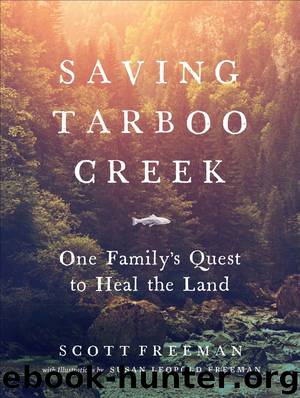Saving Tarboo Creek by Scott Freeman & Susan Leopold Freeman

Author:Scott Freeman & Susan Leopold Freeman
Language: eng
Format: epub
Publisher: Workman Publishing
Published: 2018-01-25T05:00:00+00:00
〜
The first restoration project Susan and I worked on together was near the Leopold Shack—the abandoned farm in central Wisconsin that Carl and his parents and siblings had transformed a generation before. On our walks around the place we found a little postage stamp of native prairie: a 4-acre site where a few native grasses and wildflowers were struggling to hold on, and where some swamp white oak trees were growing. It was a relict savanna—a plant community made up of a prairie understory with scattered trees.
The neighborhood where I grew up in southern Wisconsin and the campus where I was a college student in southern Minnesota had been covered with burr oak savanna when Europeans arrived. Burr oaks are stout, slow growing, thick barked, and deep rooted. All of these characteristics helped the trees withstand intermittent droughts and the fires set by native people from the Sioux, Fox, and Winnebago nations to kill invading trees and encourage grass for deer, bison, and elk. Because they grew in the open, the fire-resistant burr oaks developed wide, craggy, umbrella-like crowns. The combination of burr oaks and prairie grasses created parklands in midwestern North America akin to the Maasai Mara National Reserve in east Africa.
People respond to these environments instinctively. As our eyes sweep across a landscape dominated by savanna, it’s as if our subconscious recites, “Here is pasture for my cattle; wood for my hearth and home. The terrain is easy to travel and teeming with game. There is nowhere for my enemies to hide. The ponds and rivers have fresh, clear water, teeming with fish. Here I will live.”
We evolved in savannas and are hardwired to love them. That’s why landscape architects are always trying to reproduce them, using exotic trees and mowed grasses in corporate and college campuses. I even wonder sometimes about the savanna-like appearance of strip developments in suburban settings. Instead of grassland, there are expanses of concrete. Instead of acacia trees, there are scattered, spindly signs advertising gas stations or franchise restaurants.
When Susan and I found this bit of ragtag but actual savanna near the Leopold Shack, it was being invaded by a shrub called prickly ash. Although prickly ash is native to North America and isn’t considered an invasive, it started to take over vast swaths of the Wisconsin River floodplain after white settlers pushed the native people out. The whites didn’t follow the traditional practice of setting fires to clear out woody shrubs and young trees and encourage the prairie flora, and lack of fire led to a dramatic increase in prickly ash. Its takeover of the savanna wasn’t quite complete, however. Under and between the dense thickets of prickly ash stems, we found wisps of cordgrass, bluejoint grass, and other native species. But what made the place special was the swamp white oak trees.
The burr oak savanna that once grew in my boyhood neighborhood is rare now—vast areas have been converted to farms and suburbs, while other sites succeeded to continuous forest after Europeans arrived and controlled wildfires—but swamp white oak savanna is almost nonexistent.
Download
This site does not store any files on its server. We only index and link to content provided by other sites. Please contact the content providers to delete copyright contents if any and email us, we'll remove relevant links or contents immediately.
The Lonely City by Olivia Laing(4562)
Animal Frequency by Melissa Alvarez(4147)
All Creatures Great and Small by James Herriot(3975)
Walking by Henry David Thoreau(3676)
Exit West by Mohsin Hamid(3630)
Origin Story: A Big History of Everything by David Christian(3470)
COSMOS by Carl Sagan(3342)
How to Read Water: Clues and Patterns from Puddles to the Sea (Natural Navigation) by Tristan Gooley(3233)
The Inner Life of Animals by Peter Wohlleben(3097)
How to Do Nothing by Jenny Odell(3096)
Hedgerow by John Wright(3093)
How to Read Nature by Tristan Gooley(3070)
Project Animal Farm: An Accidental Journey into the Secret World of Farming and the Truth About Our Food by Sonia Faruqi(3007)
Origin Story by David Christian(2988)
Water by Ian Miller(2948)
A Forest Journey by John Perlin(2902)
The Plant Messiah by Carlos Magdalena(2745)
A Wilder Time by William E. Glassley(2686)
Forests: A Very Short Introduction by Jaboury Ghazoul(2665)
